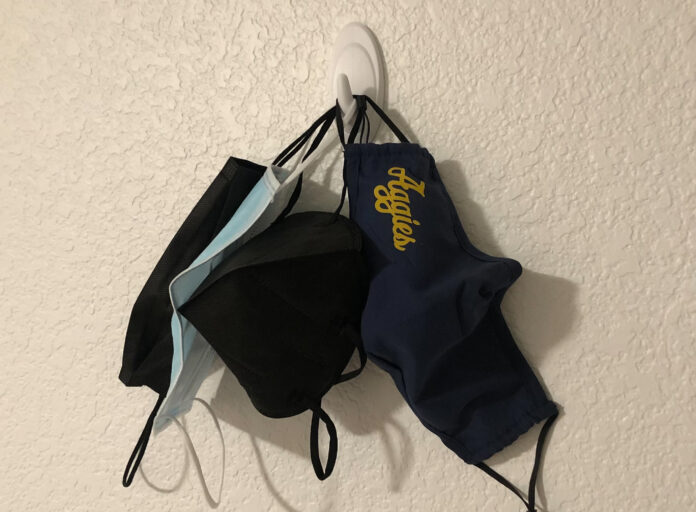UC Davis continues to require masks in indoor settings for vaccinated individuals
By SHRADDHA JHINGAN — city@theaggie.org
In a press release published on Feb. 28, the State of California changed masking requirements to a strong recommendation for vaccinated and unvaccinated people to remain masked in indoor public places. This announcement signaled the ending of the mask mandate, but as of March 3, masks are still required in “health care, long-term care, correctional, childcare and K-12 school, emergency shelter, and public transportation settings.” The mask mandate will be lifted for childcare and K-12 school settings on March 12, though they are still strongly encouraged.
These changes in guidance amended the requirements recently implemented in Yolo County on Feb. 15, when the universal face covering requirement ended in certain settings to align with guidance on masking indicated by the state of California, according to a press release on Feb. 9.
“Universal masking shall remain required in only specified settings, including public transit, K-12 schools, childcare, healthcare, correctional, shelter, and long-term care settings,” the press release from Feb. 9 read. “Only unvaccinated persons are required to mask in all indoor public settings. Fully vaccinated individuals are recommended to continue indoor masking when the risk may be high.”
With the updated guidelines as of Feb. 28, masking requirements are the same for both vaccinated and unvaccinated individuals in public settings: strongly recommended. Both of the press releases mark a shift in public health guidance from requirements to recommendations.
Public Information Officer for Yolo County John Fout explained the changes that the mask mandate adjustments would bring. According to Fout, because the number of COVID-19 cases is still considered high by the Centers for Disease Control and Prevention (CDC), masking indoors is still recommended. As of Feb. 25, the weekly trend for COVID-19 cases in Yolo County indicated 24.9 daily cases per 100,000 people.
The State of California has introduced four tiers for “masking guidance depending on risk.” These include “required, strongly recommended, recommended, and optional.” According to the press release, the transmision of COVID-19 has been decreasing in Yolo County as of late, but any changes in this trend may lead to mask requirements being instituted again.
In a press conference on Feb. 17, Governor Gavin Newsom and other officials discussed the next steps forward for California’s pandemic response. Dr. Mark Ghaly, the secretary of the California Health and Human Services Agency, discussed the use of masks.
“Let’s not just talk about optional versus required, let’s talk about recommended and strong[ly] recommended,” Ghaly said. “In California, we strongly recommend you decide to keep your mask on when you’re in indoor high-risk places, and that’s going to continue until we see the signals that it’s okay to recommend it and then make it optional, so it’s not just a single level.”
According to the press release, people are recommended to wear a tightly fitting mask.
“The end of a masking requirement does not signal that masks do not work,” the press release reads. “Masks work. We recommend that anyone who feels unsafe in any situation wear a mask that fits and filters well, such as an N95, KN95, or KF94 respirator or double mask with a cloth mask over a surgical mask.”
Fout said that with the changes in the mask mandate, most universities, including UC Davis, will continue to require masks as masking helps prevent the spread of COVID-19, particularly in settings such as indoor classes.
“So yes, in this case, so UC Davis is sort of a unique case in a sense because obviously there are a lot of indoor classes,” Fout said. “[…] Many students have masks and there’s HEPA filters, it still could be a situation where it just makes more sense for the moment to maintain masks, particularly with transmission of high levels. So UC Davis certainly can choose how they want to mask separately, most colleges and universities are following that to continue the masking.”
Dr. Daphne Darmawan, a pediatrician at UC Davis Children’s Hospital, explained ways to reduce transmission indoors at home in a video, such as opening windows, minimizing visitors and more.
“90% of COVID-19 transmission occurs indoors [….], so it’s really important to improve the ventilation in your home, especially when you’re having visitors,” Darmawan said.
Fout also explained that this change was possible since there are less hospitalizations and more vaccinations.
“But the reality is that something different has happened that we haven’t seen before,” Fout said. “With the Omicron variant, […] we saw a decoupling between cases and hospitalizations. So while we hit all time highs for cases and broke through our all time high for a previous surge very easily, we actually had fewer hospitalizations.”
Written by: Shraddha Jhingan — city@theaggie.org



